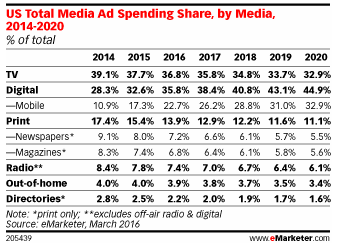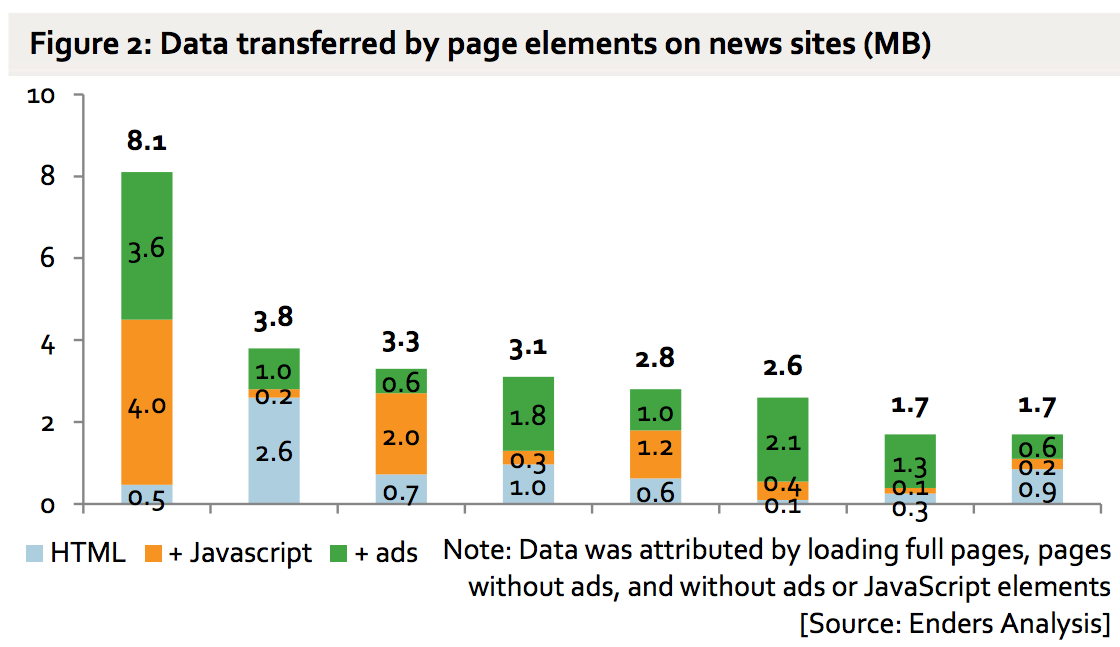The amount of mobile data news site ads consume, magazines’ total social media audiences, digital ad spending projections, the importance of cross-device synchronization, and more are covered in this installment of TFP’s Media Metrics roundup.
To help you keep up with trends and prepare for changes just around the corner, each month we compile excerpts from some key reports covering issues affecting the publishing and media industries. Here are our top picks.
Ads on News Sites Gobble Up as Much as 79% of Users’ Mobile Data (Business Insider)
- A study from Enders Analysis found ad content accounted for 18% to 79% of mobile data transferred.
- JavaScript elements, which publishers frequently use for ads and visuals like animations, increased use of mobile data by another 6% to 68%.
- Based on the findings, researchers estimated advertising accounts for approximately half of all the data used by publisher pages loaded over mobile data networks on the iPhone 6.
Magazines Boost Social Media Audiences (MediaPost)
- The Association of Magazine Media reported that consumer magazines increased their total social media audience by more than a third in 2015, adding 220 million new likes and followers across major platforms.
- Instagram was the fastest growing platform for magazines last year, with a 189% increase in followings.
- Consumer magazines also showed more social activity than all other media, according to separate data from Shareablee. Magazines last year generated 9.5 billion total social actions, compared with 7.5 billion for TV and 6.6 billion for online-only media.
- The MPA said magazine brands grew audiences 7.1% in 2015, to nearly 1.7 billion.
Study: Digital Ad Spending to Overtake TV by 2017  (Folio Magazine)
(Folio Magazine)
- Mobile ad spending will hit $43.6 billion in 2016, a 38% year-over-year increase. Based on that projection, digital ad spending will surpass TV’s majority share in 2017, according to an eMarketer report.
- Mobile now makes up 63.4% of total digital ad spending. By 2020, it will account for about 70% of total digital ad spending and 32.9% of overall spend, bringing it to the same level as TV.
- Print magazines will take a 6.8% share of total ad spending in 2016 and only 5.6% by 2020, the report said.
Study: Customers (Especially Millennials) Hate When You Fail To Deliver Cross-Device Experiences (Social Times)
- A new Adobe study found that 66% of users get frustrated when content isn’t synchronized across their devices.
- It said millennials are the largest cross-device group, with 90% saying they switch devices mid-activity compared with 76% of Gen Xers and 58% of those 55 and older. Overall, 79% move from one device to another during an activity.
- On average, consumers own 7.2 devices and use 3.1 devices daily.
- According to the study, 92% of consumers own smartphones, and 26% of those polled said they own two or more smartphones.
Ad Fraud Will Cost $7.2 Billion in 2016, ANA Says, Up Nearly $1 Billion (Advertising Age)
- Bot traffic will lead to $7.2 billion in ad fraud losses globally in 2016, up from $6.3 billion in 2015, according to a study by the Association of National Advertisers and digital security firm WhiteOps.
- Marketers said bots (automated software programs) represented 3% to 37% of the impressions for their ads, up from 2% to 22% last year.
- Programmatic display ads saw 14% more bots than the study’s overall average, while programmatic video had 73% more.
Only 3% of Top Publishers Directly Addressing Ad Blockers: Study (Marketing Dive)
- A study of 250 top North American publishers found only eight (3.2%) are addressing use of ad blocker technology by blocking access or asking visitors to turn off ad blocking software.
- Only three publishers (Wired, Forbes, and GQ) block access to their content until users either turn off ad blocking software or pay for an ad-free subscription.
- One Canadian publisher (Narcity) lets visitors using ad blocking software access content if they sign in through Facebook, which offers the publisher data about the visitor.
- The study found 10 homepage elements were blocked on average, and 11 elements were blocked on article pages, including display ad units, recommendation widgets, native ad units, and tracking scripts.
Yahoo: 79% of Generation X Are Smartphone Users (Social Times)
- Members of the Gen X demographic have the highest median income by household and the highest spending power of any generation, Yahoo research shows.
- It also found that Gen Xers are big mobile and social media users: 79% use smartphones, a figure that’s projected to increase to 88% by 2018, and 43% share social media content.
- The group also regularly multitasks, with 84% reporting they use multiple devices between 7-11 p.m., and switch between them 9.2 times per hour.
Media Metrics is a monthly feature from Technology for Publishing, aimed at keeping you armed with the latest industry data. If you’d like to share something you’ve read, drop us a note. And keep up with the latest industry news coverage by signing up for our This Week in Publishing emails or our Publishing Innovations newsletter.
Posted by: Margot Knorr Mancini



